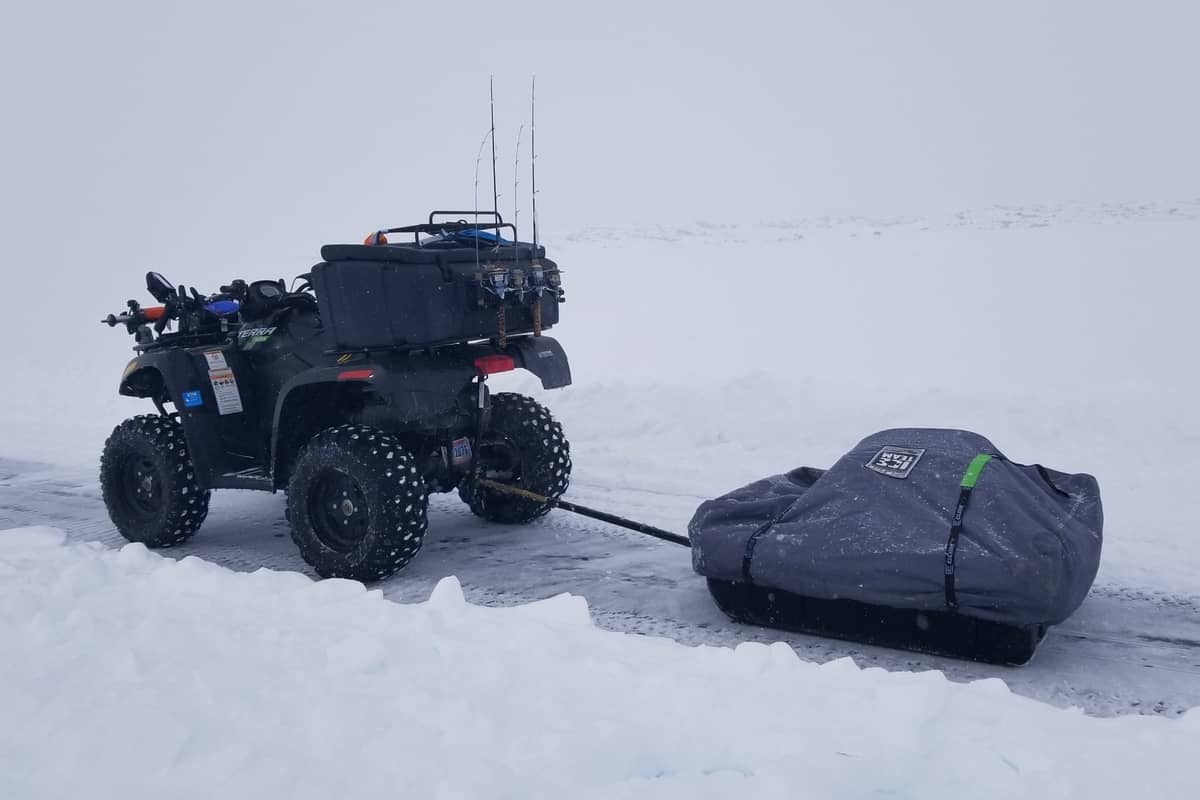This post contains affiliate links.
When you’re out ice fishing your favorite lake with your trusted ice sled, you often take for granted just how effective a piece of equipment it is (especially when lugging all your gear behind you!) until it breaks or gets a hole in it. But how exactly do you go about repairing a hole in an ice fishing sled so that you don’t have to be without this critical piece of equipment?
Several methods can be employed when repairing a hole in an ice fishing sled, including plastic welding, fiberglass and resin, epoxies, and gluing. Plastic welding is the best choice for most holes. The method chosen depends on your expertise, how large the hole is, and where the hole is located.
With all of these techniques available, it may be challenging to choose one. So before starting, ask the questions, “Which method works best?” And “how do you prevent holes from reoccurring in the future?”
Ice Fishing Sled Repairs, Holes And How To Fix Them
When it comes to repairing holes in ice fishing sleds, two techniques stand out above the others.
- Using fiberglass and resin
- Using a plastic welding machine
The method that you select will depend on several variables.
- The size of the hole to be repaired
- The location of the hole
- The material the sled is made from
- Your available budget
- Your experience in DIY/repairs
Glue and epoxy are limited in their effectiveness when attaching to polyethylene. The best option is to try and use similar material, heat it and patch the hole.
Using Plastic Welding To Fix A Hole In An Ice Sled
The use of plastic welding (or an adaptation to plastic welding) to fix holes in ice sleds is generally agreed to be the best option.
There are a few plastic welding brands available, and if you have a Harbor Freight store close by, you can buy one there at a reasonable price. If not, this Massca Plastic Welding Kit with Rods and Reinforcing Mesh below from Amazon is one I have used in the past, and I find it to be a good one and cost-effective.
The concept and process are simple and effective. By heating the “plastic” surrounding the hole, it becomes tacky and malleable. The heating-up process is either through hot air or using a metal iron (like a soldering iron).
Once it is hot, you have a few options available depending on the size of the hole to be fixed.
For most plastic welding sets, you can purchase plastic “sticks,” which are melted with the same hot air/iron. This plastic is melted over the hole and welded together with the sled’s remaining material.
By using a roller, you smooth over the weld and help it to fuse better. This is practical for smaller holes.
If the hole is much more significant, you need to find a replacement piece of material that matches the sled’s material (e.g., polyethylene for most store-bought sleds). The exact process is followed, welding the edges of the patch to the remaining sled material.
Pro Tip: An alternative I have used on my own and my friend’s sleds are to cut off a lip section on top of the sled and weld that on using a soldering iron/blow torch.
Many people use old milk containers made of the same polyethylene material to patch ice fishing sleds.
Using Fiberglass And Resin To Fix A Hole In An Ice Sled
Fiberglass is a method that is less popular than plastic welding. It does, however, work for about a season, so if it is the only option available, then it will have to do!
To patch a sled with fiberglass is more or less the same as with anything you are fiberglassing.
First, prepare the surface (clean of all loose pieces and dirt), lay the fiber mat over the hole (make sure it overlaps the whole area), and apply the resin. Start on one side and try to push any air bubbles out of the mat.
After it dries, the fiber mat should be firmly attached without lifting pieces.
The downside to using this is that the patch generally does not lie flush with the sled, and it will create extra drag/get caught on branches, etc.
You can smooth it down as much as possible, but be careful not to remove too much fiberglass and undo your work.
Other Methods And Products To Repair A Hole In A Sled
There are additional methods to employ when repairing holes in ice fishing sleds if the required expertise or budget to use fiberglass or plastic welding is lacking.
These methods include:
- Using P-tex
P-tex is a polyethylene repair compound for skis and snowboards. Its application depends on the type of product purchased. First, roughen up the edge of the hole with sandpaper, then apply the P-tex compound to the cavity by heating it and dripping it on.
- Hot Glue
In situations where the hole is less than two inches across, using hot glue can be effective. Squirt the glue into the hole, smooth it off so that it’s flush, and wait for it to dry.
- Modify your sled by adding skis to the bottom (lifting it off of the ground).
After closing the hole up by gluing a patch on or using an epoxy such as JB weld, or super glue such as E6000, you can attach skis to the bottom to prevent future holes from occurring.
This would be recommended as a follow-up practice to any repair job.
- Relining the sled
You can do this with other plastic materials (old drums, sleds, parts from a scrapyard, etc.) or lightweight aluminum. By lining the bottom and inside of the sled, you should be able to extend the lifespan of an aging ice sled.
- If the hole is decidedly large, it may be better to retire the sled and upgrade to one that is less porous! I would recommend adding skis to the bottom (a Smitty Sled design), which should improve the longevity of the sled.
What Generally Causes Holes In Ice Sleds?
Ice sleds are subjected to some pretty extreme abuse.
The rugged terrains that sleds are dragged across include ice, snow, and rocks. If your ice sled doubles up as a hunting and fishing sled, it is exposed to even more varying environmental conditions.

Aside from the sled moving over rough terrain, the sun, rain, and freezing temps also play a role in breaking down plastic polyethylene.
Harsh conditions and weather do not promote the longevity of sleds, so it is only a matter of time before even the best-made sled develops a hole or few.
These holes generally occur on the sled’s bottom, as this is the point where all the “wear-and-tear” is experienced.
A great way to prevent this would be to add skis to the sled’s bottom to raise it off the ground, reducing the wear and tear factor tremendously.
Repairing The Damage Yourself Vs. Taking It To A Repair Shop
The choice between DIY vs. a service shop comes down to your skills, budget, and time constraints.
It is cheaper to repair holes yourself (generally); however, purchasing fiberglass or a new plastic welder is not always that cheap.
Two questions to ask yourself before trying to repair a sled are:
- Are you confident enough to use the fiberglass and resin or the plastic welder (or any other repair product) to fix your sled?
- And do you have enough time to do it?
It is often easier to take your sled to a repair shop and get them to do it for you.
Having a shop do the repairs will be the more expensive approach, but they should have all the tools and materials required to patch the hole quickly and efficiently.
Conclusion
When fixing a hole in an ice sled, the most recommended method is a plastic welder. There are, however, other alternatives, like fiberglass, epoxies, and glue. Before repairing the hole, you should decide if you want to do it yourself or have a store do it for you, depending on your budget, skill, and time constraints.
Have fun and stay safe out there!

